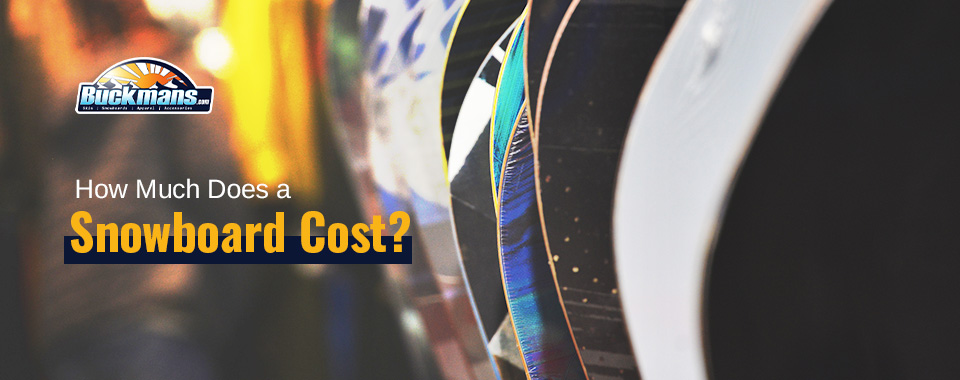 Snowboard Cost
Snowboard Cost
How Much Does a Snowboard Cost?
Posted
by
Matt Gahman
on Tuesday, June 11, 2024
Whether you're a complete snowboarding beginner or an experienced slope addict, you'll want your own gear at some point. Before you start shopping blindly, knowing how much a snowboard is and what you need to stay safe, warm and comfortable is essential. Snowboarding makes up 30% of winter sports participants, so you have plenty of gear to choose from.
A snowboard can cost $200 to over $1,500, depending on the brand, condition and features. Then, you must factor in the cost of snowboard equipment. The more you know, the better your decision-making and the more enjoyable your ride.
- Why Are Snowboards So Expensive?
- What Factors Affect the Price of a Snowboard?
- Primary Considerations When Buying a Snowboard
- What Other Gear Do You Need?
Why Are Snowboards So Expensive?
The price of a snowboard may seem high at first glance. It makes sense once you consider that they are finely tuned equipment designed and manufactured to operate in subzero temperatures. Many factors dictate the cost of a decent snowboard, including:
1. Manufacturing and Materials
Snowboards must withstand challenging environments, so manufacturers use reliable performance materials. Then, add the cost of production — the experts and advanced technology that take these materials and turn them into premier snowboards.
Around 8.98 million Americans went snowboarding in 2023 alone, and every snowboarder has different needs. Snowboards are made up of different materials that surround a wood core to create unique boards in how they flex, turn, ride and feel, which can further influence prices.
2. Innovation and Technology
Snowboards have come a long way since their start in the 1960s. Like any sport, snowboard brands are always looking to improve, challenging themselves to create better-performing boards and push the boundaries of the sport.
What was once a piece of shaped wood is now composed of different types and densities of wood engineered to be stiffer in some spots and more flexible in other spots and sandwiched between different layers. Boards have different shapes and profiles that are tested and improved every year to bring a better riding experience for snowboarders of any level.
3. Sponsorship and Marketing
Snowboard brands must invest in standing out. To do so, they can sponsor top athletes and invest in expert marketing. They factor these costs into board production, which often translates to higher prices.
So much goes into developing, manufacturing and marketing snowboards. It might be tempting to search for a good deal, but if it looks too good to be true, it probably is. Shopping for boards anywhere other than reputable snowboard shops comes with risks. You want to rely on your equipment, which could mean spending a little extra upfront.
What Factors Affect the Price of a Snowboard?
While you can get an idea of an average snowboard cost, the prices of boards vary significantly depending on the board and the athlete. The trick is to find the best snowboard for you, which means taking into account the following factors:
1. Your Skills
Skill level is one of the most critical factors in snowboard pricing:
- Beginner: If you're a beginner, a less sophisticated brand works in your favor, as these boards are more forgiving. Beginners can expect to pay between $200 and $600 for a board.
- Intermediate: Intermediate riders want enhanced speed and performance. Boards for this skill level are stiffer and incorporate higher-quality materials and design. They typically retail for between $300 and $800.
- Advanced: Advanced boards retail between $350 and $1,500 and provide the highest levels of performance. While advanced snowboarders can still enjoy many beginner and intermediate boards, beginners may find advanced boards unnecessarily challenging.
2. The Brand
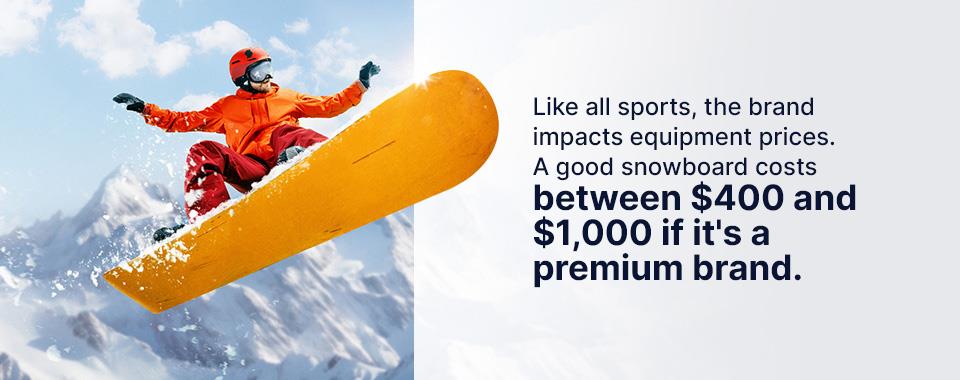
Like all sports, the brand impacts equipment prices. A good snowboard costs between $400 and $1,000 if it's a premium brand. If you're an amateur snowboarder who likes to get out there and have a good time, remember that premium brands spend more on marketing and R&D, which drives the price. Although they use the highest-quality materials and cutting-edge technology to enhance the experience, you can get the same enjoyment from a more cost-effective brand.
The trick is to balance quality and cost-effectiveness. Many brands, from premium to more cost-effective, have various boards, including budget and premier options. For example, Burton offers some of the most deluxe, high-tech boards on the market. They also have budget options for beginners. Rossignol is an excellent brand for more budget-friendly boards.
3. The Type of Snowboard
Another factor that influences the price of a snowboard is the type of board. Each type of snowboard features a design that suits its specific purpose. Materials and features all affect the price. Some common types of snowboards include:
- All-mountain snowboards: These versatile, all-purpose boards are reliable in almost any terrain or condition. This type of board is popular among beginners and more advanced riders alike for its versatility. They give you the freedom to navigate different parts of the mountain, from park runs to groomers and powder. They have a medium flex and cost an average of $300 to $900.
- Alpine snowboards: Also known as "carving boards" or "race boards," these boards are made for high-speed carving on smooth, groomed slopes. They are normally narrow with a stiff flex and are best suited to experienced riders. You can expect a price tag of between $500 and $1,000.
- Powder snowboards: If you love floating through the backcountry, a powder snowboard is ideal for fresh snow conditions. The board has a generous amount of rocker, and the binding inset position helps with accurate steering. It costs between $400 and $1,000.
- Free ride boards: Free ride boards have one primary purpose — speed. Although the design supports use on natural, backcountry terrain and deep snow, you can zip down groomers and enjoy the adrenaline rush. They have a directional shape and setback stance with a stiffer body for high-speed carving. These versatile boards start at around $400, but top-of-the-range models cost over $1,000.
- Freestyle snowboards: Common among park riders, these boards have a medium to soft flex and true twin shape. The average price of a freestyle board is $300 to $800. They're best in the terrain park because they are easier to maneuver for tricks and provide more pop-off jumps, but the freestyle board can be unstable at high speeds.
- Splitboards: If exploring the backcountry is your thing, the splitboard's versatile and specialized design lets you separate it to skin uphill. The board's advanced design and features have a heavier price tag of $600 to $1,500. You'll also need splitboard binding and climbing skins to enjoy the design.
Splitboards are among the most expensive snowboard types, while freestyle boards are the most budget-friendly. If you're a beginner, focus on all-mountain or freestyle boards. You can always look at other board types as you sharpen your skills.
4. The Board's Condition — Buying New vs. Used
Snowboards depreciate in value from the moment you use them, which is good for people looking for bargains. You can get a good deal on a barely used snowboard if you work with a reputable retailer. A used board that's seen a lot of action might not be such a bargain after all.
New snowboards come with peace of mind. You know what you're getting. There's no need to settle for whatever you can find. However, all these perks mean more spending. If you want to save money, used boards are an excellent option, provided you know enough to assess their condition, use and expected life span.
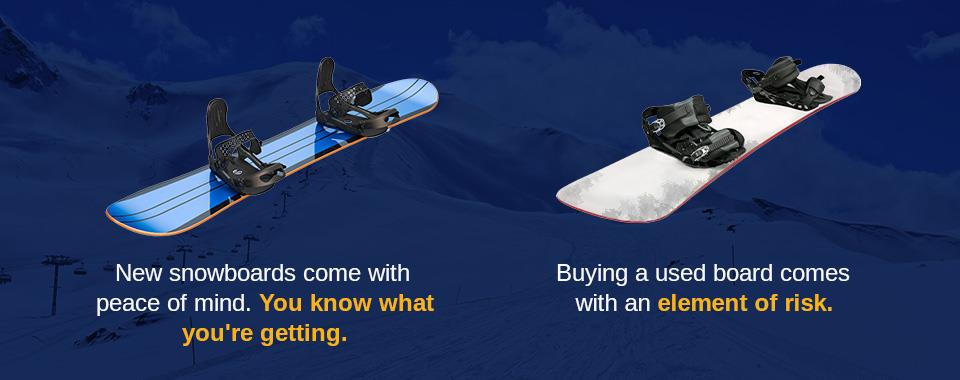
Buying a used board comes with an element of risk. Retailers often offer warranties on used boards. If you can find gear that hasn't seen much action, you could end up with a nearly new board without breaking the bank. Consider the board's age and inspect the base, top sheet, flex and edges for damage. It's best to work with professionals to ensure you're saving money and not just buying someone else's problem.
5. Features and Extras
The manufacturing process, from materials to technology, influences snowboard prices. If you want a snowboard with premium materials and advanced technology, you'll need to spend a little extra.
Advanced technology and superior materials, like added carbon fiber and sintered bases, improve board performance and resilience, meaning you can expect more if you spend more. However, standard features still give you a solid and reliable ride without the extra expense.
Some features to consider are:
- Bases: Sintered bases are more expensive than extruded ones and require more maintenance. Extruded bases are more affordable upfront and more economical to repair, making them a fantastic option for beginners or casual boarders.
- Materials: Kevlar, graphite and bamboo are some materials that drive up snowboard prices.
- Technology: Advanced technologies like wavy or asymmetrical edges, mixed-material cores and graphite treatments make a board more expensive, as they improve performance.
- Shape: As manufacturers push boundaries, new board shapes emerge, many with a premium price tag.
Primary Considerations When Buying a Snowboard
Choosing the right board can be challenging, given the many types, materials and features. The most important thing to remember is that the board must match the rider's size, skill level and preferences. Some critical factors to consider when buying a board include:
Riding Style
Your riding style is critical to finding the perfect board. If you like exploring the backcountry, a splitboard or powder board is a great place to start. A freestyle snowboard is a better bet if you prefer riding in the park. All-mountain boards are ideal if you are a beginner or still looking for a niche.
Flex
Snowboard flex refers to the board's stiffness, which can affect your riding experience. A board with a softer flex is more forgiving for beginners and makes turning easier. Advanced riders often opt for a stiffer flex, giving them more power transfer and stability when carving down slopes. Board flex is ranked between 1 and 10 or soft to stiff.
Length and Width
The length and width of a board determines its maneuverability. Since snowboarding is a sport the whole family can enjoy, different lengths and widths exist to suit all riders. On average, board length varies from 150-230 centimeters with widths of 50-120 millimeters. Beginners often find shorter and broader boards easier to control. Advanced riders seeking stability frequently go for longer and narrower boards.
Your height and weight determine the best board length for you. The taller and heavier you are, the longer the board. The rule of thumb is that your board should be wide enough so your boots barely hang over the edge. You may need a wider board with larger feet, but a standard width suits anyone under a shoe size 10 (U.S.).
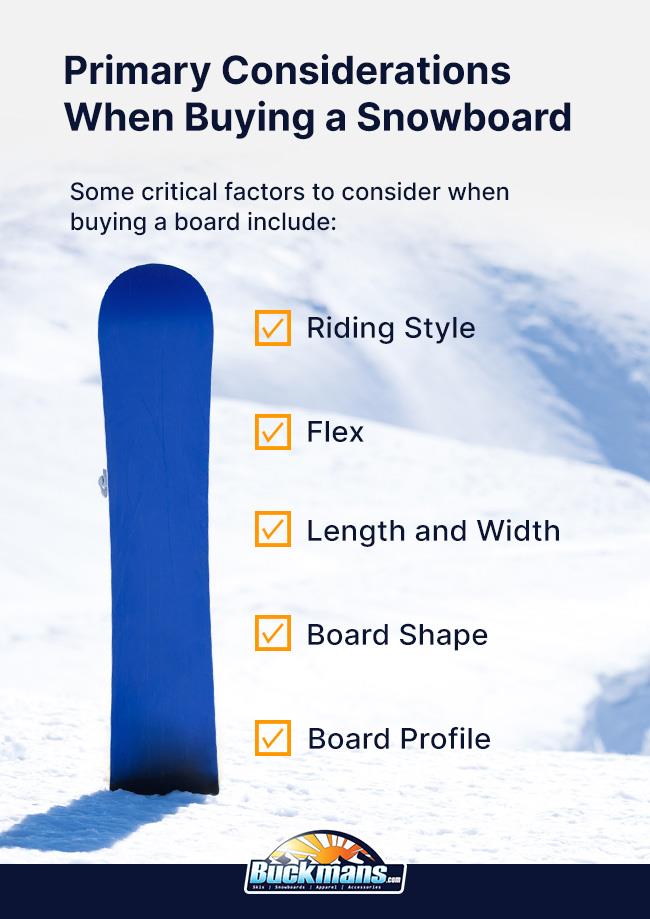
Board Shape
A snowboard's shape affects its performance and maneuverability. For example, a directional shape is ideal for riding in one direction, while a twin shape is best for riding switch. New shapes are in the works all the time, but some of the most common include:
- Directional: These profiles are typical in powder boards, but you can also find them in all-mountain. They're stiffer in the tail with a wide, soft nose for stability at high speeds, and they float better in powder. The bindings are positioned closer to the tail.
- True twin: These boards are entirely symmetrical in shape, so they feel the same whether you ride switch or regular.
- Directional twin: Directional twin boards combine directional and twin shapes. This shape works best on all-mountain and freestyle terrain.
- Volume-shifted: These boards are short and wide, pushing your weight to the back of the board and keeping the nose elevated. They're highly maneuverable, especially in the backcountry and deep powder.
- Asymmetrical: Asymmetrical boards have a shorter and deeper sidecut along the heel to make heel-side turns easier, improve maneuverability and help with balance. These boards are easier and can be more fun, but they are not always necessary for beginners.
Board Profile
When you look at a board from its side, you'll notice the board curves. Different curves exist in different spots on the board to change how it performs:
- Rocker: Rocker is the downward curve that lifts the board's tip and tail off the snow. It provides more float in lighter snow and more maneuverability. This board is ideal for beginners and advanced riders, giving you maneuverability and confidence.
- Flat: As the name suggests, these boards are flush with the snow aside from a regular tip and tail rise to keep the board from catching. Some flat profiles add more rocker to the tip and tail to lift the ends further off the snow for more maneuverability and ease of use.
- Camber: Despite being one of the earliest board designs, a traditional camber still offers the highest performance, stability, precision, pop and powerful energy transitions. Camber is the upward curve that lifts the board off the snow. Traditional camber, where there is little to no rocker, can be more challenging to manage, making it better suited to more experienced riders.
- Rocker camber hybrid: This design combines the benefits of each curve into one snowboard. The rocker at the ends of the board and between your feet helps reduce the board's edges from catching, makes turn initiation easier and provides more float in powder. Camber under your feet provides more stability, better edge hold and pop.
What Other Gear Do You Need?
When you budget for a board, include any other snowboarding gear you need to have fun and stay safe on the slopes. If you're a beginner snowboarder, make sure you have the following gear along with your new board:
- Boots: If you spend extra time finding one piece of equipment, it should be your boots. If they're uncomfortable, your board and bindings cease to matter. Boots should fit properly and support your feet. The most important thing is to ensure they fit correctly, so it's always best to consult a professional before buying.
- Bindings: Finding bindings is pretty simple. Most bindings are compatible with any board, but some require a specific binding mount pattern or specialized binding discs to fit with certain boards. Make sure they correspond with your boot size. It's also important to note that women's bindings are shorter and narrower, so build your binding around your boot.
- Helmet: Safety always comes first on the slopes. Again, sizing and fit are critical. If your helmet is too big, taking a fall could cause more damage. Get your helmet correctly fitted by a professional.
- Mittens: Protect your hands from the cold with a good pair of mittens. Look for waterproofing, insulation, breathability and durability. When you're learning to ride, your hands see plenty of snow, so mittens are even more essential.
- Goggles: While not strictly necessary, goggles are an awesome addition to your gear. They protect your eyes from glare without restricting your vision like regular sunglasses. Look for lenses that match the exposure you'll ride in each day.
- Outerwear: One of your main priorities on the slopes is staying warm and comfortable when you ride. Your outer layers should be waterproof, insulated and breathable, so take the time to find the clothing that works best for you. Make sure you layer up underneath so you're fully prepared for a day in the snow.
Browse Buckman's Ski and Snowboard Shops' Selection of Snowboards
There are plenty of factors to consider when buying a snowboard, from finding one that suits your budget to matching it with your skill level and riding style. The best way to ensure you end up with the perfect board is with expert guidance from experienced professionals.
At Buckman's Ski and Snowboard Shops, we've provided quality products and exceptional customer service to winter sports enthusiasts since 1971. As one of the first ski shops in the nation to carry snowboarding gear and apparel, we have evolved with the sport since the beginning.
You can expect premier brands and expert guidance at any of our seven retail store locations throughout eastern Pennsylvania. Find a store near you and pop in for an in-person chat, or contact us online for all your snowboarding apparel, equipment and accessories!
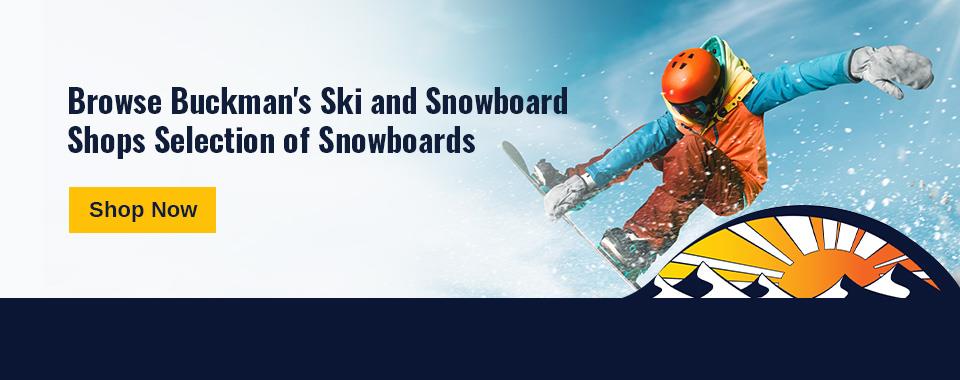
Categories:
Snowboard Equipment
|
Top Winter Brands
Tagged: snowboard, ski and snowboard equipment